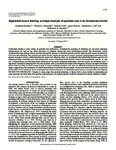Biparental mucus feeding: a unique example of parental care in an Amazonian cichlid
| dc.contributor.author | Buckley, J | |
| dc.contributor.author | Maunder, RJ | |
| dc.contributor.author | Foey, A | |
| dc.contributor.author | Pearce, J | |
| dc.contributor.author | Val, AL | |
| dc.contributor.author | Sloman, KA | |
| dc.date.accessioned | 2018-10-24T10:45:58Z | |
| dc.date.available | 2018-10-24T10:45:58Z | |
| dc.date.issued | 2010-11-15 | |
| dc.identifier.issn | 0022-0949 | |
| dc.identifier.issn | 1477-9145 | |
| dc.identifier.uri | http://hdl.handle.net/10026.1/12620 | |
| dc.description.abstract |
<jats:title>SUMMARY</jats:title> <jats:p>Vertebrates display a wide variety of parental care behaviours, including the guarding of offspring pre and post nutritional independence as well as the direct provision of nutrients during the early development period. The Amazonian cichlid Symphysodon spp. (discus fish) is unusual among fish species, in that both parents provide offspring with mucus secretions to feed from after hatching. This extensive provision of care, which can last up to a month, imposes a physiological demand on both parents and gives rise to conflict between the parent and offspring. Here, we investigated the relationship between parents and offspring during a breeding cycle, determining both mucus composition (total protein, cortisol, immunoglobulin, and Na+, K+ and Ca2+ concentrations) and the behavioural dynamics of the parent–offspring relationship. Over the course of a breeding cycle, a significant increase in offspring bite rate was recorded, with a concomitant increase in the frequency of turns the male and female parent took at caring for their young. A peak in mucus antibody provision was seen as offspring reached the free-swimming stage, suggesting a role analogous to colostrum provision in mammals. Mucus protein content was lowest during the second and third weeks of free swimming, and a weaning period, similar to that seen in mammalian parental care, occurred when the offspring had been free swimming for ∼3 weeks. In many ways, the parental behaviour of discus fish is more similar to mammalian and avian parental care than other fish species, and represents an exciting aquatic model for studying the parent–offspring conflict.</jats:p> | |
| dc.format.extent | 3787-3795 | |
| dc.format.medium | ||
| dc.language | en | |
| dc.language.iso | eng | |
| dc.publisher | The Company of Biologists | |
| dc.subject | discus fish | |
| dc.subject | cichlid | |
| dc.subject | immunoglobulin | |
| dc.subject | mucus | |
| dc.title | Biparental mucus feeding: a unique example of parental care in an Amazonian cichlid | |
| dc.type | journal-article | |
| dc.type | Article | |
| plymouth.author-url | https://www.ncbi.nlm.nih.gov/pubmed/21037057 | |
| plymouth.issue | 22 | |
| plymouth.volume | 213 | |
| plymouth.publication-status | Published | |
| plymouth.journal | Journal of Experimental Biology | |
| dc.identifier.doi | 10.1242/jeb.042929 | |
| plymouth.organisational-group | /Plymouth | |
| plymouth.organisational-group | /Plymouth/Faculty of Health | |
| plymouth.organisational-group | /Plymouth/Faculty of Health/School of Biomedical Sciences | |
| plymouth.organisational-group | /Plymouth/REF 2021 Researchers by UoA | |
| plymouth.organisational-group | /Plymouth/REF 2021 Researchers by UoA/UoA01 Clinical Medicine | |
| plymouth.organisational-group | /Plymouth/REF 2021 Researchers by UoA/UoA01 Clinical Medicine/UoA01 Clinical Medicine | |
| plymouth.organisational-group | /Plymouth/Research Groups | |
| plymouth.organisational-group | /Plymouth/Research Groups/Institute of Translational and Stratified Medicine (ITSMED) | |
| plymouth.organisational-group | /Plymouth/Research Groups/Institute of Translational and Stratified Medicine (ITSMED)/CBR | |
| plymouth.organisational-group | /Plymouth/Users by role | |
| plymouth.organisational-group | /Plymouth/Users by role/Academics | |
| dc.publisher.place | England | |
| dc.identifier.eissn | 1477-9145 | |
| dc.rights.embargoperiod | Not known | |
| rioxxterms.versionofrecord | 10.1242/jeb.042929 | |
| rioxxterms.licenseref.uri | http://www.rioxx.net/licenses/all-rights-reserved | |
| rioxxterms.type | Journal Article/Review |


